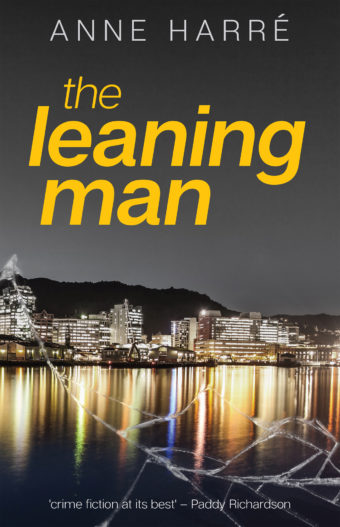Early in Ann Harré’s debut novel, The Leaning Man, the main character, Stella Weston, visits her favourite sculpture on the Wellington waterfront. She admires what she calls ‘the leaning man’, which she sees as ‘a fine pencil drawing.’ Beside the sculpture lies a small pair of jandals, ‘pink with a little flower that would rest between the wearer’s toes.’ The juxtaposed images: the beauty of the sculpture, the frailty of the child’s abandoned footwear, the ‘black, oily water’ and the ‘raw edge’ of night create the unsettled atmosphere that pervades the novel. Nothing is quite as it seems.
Characters slip away from first impressions. Stella’s lovely and conventional mother — aptly named, Peace — and equally lovely sister, Charlotte, have secrets. Mad-Dog, now a homeless man, was formerly a talented musician. Kate, Stella’s friend, is also Kitty LaFoy, a worker in a shady nightclub. Teri, the pretty party girl, ‘all halter-neck and cleavage,’ dies keeping a secret. Is the mysterious Maurice Ravosky somehow linked to Teri’s death? — how could you possibly put your faith in a man with buffed nails and a diamond ring on his pinky finger? Even seemingly solid and reliable Mitchell Lassiter, Stella’s friend and potential lover, comes under scrutiny. There are twists, slides, misunderstandings. Permeating all of this is Wellington, a city of culture and order. Chip away and you discover poverty, violence and exploitation of the vulnerable and the powerless.
Even tough, cynical Stella reveals vulnerability, ‘She wanted to be the person who knew things, a person who could lean fearlessly into the unknown, forge ahead, get things. That had been her. Once.’ A former member of the New Zealand police force, Stella escaped to the U.K. to evade the scandal that erupted following the catastrophic ending to her affair with a married colleague. Being in Wellington is uncomfortable; she doesn’t want to be reminded that her life in London with her job as a private investigator surveilling cheating husbands is a poor substitute for what she had. Brittle, disobliging and carrying a grudge towards her more conventional sister — ‘Her wedding had been ultra-traditional right down to the tears the bride had shed while walking up the aisle’ — initially, she is provoking rather than likeable. Harré slowly and skillfully reveals Stella’s strengths as well as her failings; driven, impulsive and careless of herself as well as of her family, she is also loyal and determined. I enjoyed the way Harré has her change and grow over the course of the novel. She finally faces the shame which caused her to run away, yet recognises her own worth and the possibility of new and different choices.
Harré weaves her story in short, sharp chapters; the language is economical and tight, the characters surprise and the plot is deftly constructed. The opening chapter, where we are taken into the world of the homeless, the Wellington of Mad-Dog, creates immediate curiosity and intrigue. We move with him through the streets in his search for the cardboard which will keep him warm and protected at night. His voice is both compelling and convincing as he observes an angel falling from a balcony and discovers a fallen star.
The novel then shifts focus to Stella, home for her parents’ fortieth anniversary. At the party she speaks with Teri, her closest friend, who tells Stella she has a secret, information, she wants to share with her. That night Teri dies, falling from her fourth-floor apartment. While everyone suspects suicide, Stella refuses to believe it. Following her friend’s death, Stella discovers the drowned body of a child — a little girl. The subsequent action of the novel, involving Stella’s growing suspicion that somehow the deaths are linked, leads her into the corruption beneath Wellington’s respectable surface: the spa, the night club, where her friend Kate works and the realities of those forced into homelessness. The plot twists and jolts; just as you imagine everything is solved and everyone safe, there is another startling revelation. It seems there is always a further side-street looming; ‘another alley — dark and filthy — a rotten smell.’
The narrative moves between Stella and Mad-Dog, the unfortunate witness to Teri’s death. As in the best crime fiction, The Leaning Man is slick, engaging and compelling, but this novel also provides insight into the homeless, a part of our society which hovers beneath our usual regard. Harré vividly shows us their world, the stories of their pasts, their poverty, deprivation, the friendship which binds them and the threat of violence they must live with. The novel also courageously exposes and confronts the exploitation of children used in the sex trade. While Stella saves one child, the chilling images of what she witnesses are powerful reminders of what may happen to the most vulnerable of our society.
The Leaning Man is a cracking good story, but what lingers most from the novel is the representation of the powerless, the homeless, their hunger, cold and fear. This is Anne Harré’s first novel. I’m looking forward to the next.
This review was originally published on the Academy of NZ Literature site.



